History of Lithuania: Introduction
First known habitation of Lithuania dates back to the final ice age, 10 000 BC. The hunter-gatherers were slowly replaced by farmers. The origin of Baltic tribes in the area is disputed but it probably dates to 2500 BC. These forefathers of Lithuanians were outside the main migration routes and thus are among the oldest European ethnicities to have settled in approximately the current area.
These Baltic peoples traded amber with Romans and then fought Vikings. In the era, only one small tribe from the area around Vilnius was known as Lithuanians but it was this tribe that consolidated the majority of other Baltic tribes. This process accelerated under king Mindaugas who became a Christian and received a crown from the Pope in 1253. After his death, the Grand Duchy of Lithuania fell back to pagan ways leading to a centuries-long conflict with Teutonic Knights.
The eventual adoption of Christianity by Grand Duke Jogaila (1387) did not stop the knights. Lithuanians forged a long-lasting alliance with Poland that eventually extinguished the Teutonic threat. Ruled by Grand Duke Vytautas Lithuania became the largest state in Europe, stretching from Baltic to the Black sea in the 15th century.

Battle of Žalgiris (Grunewald) by Jan Matejko. This vanquishing of the Teutonic knights is seen as the main medieval triumph of Poles and Lithuanians by romanticist historians. Streets and sports franchises are named after Žalgiris.
A new threat came from the east with Moscow rapidly gaining power and conquering lands. In response, Lithuania and Poland formed a Commonwealth in 1569. Initially, it was successful in deterring enemies. However, the political union led to gradual Polonization of the Lithuanian nobility as Lithuanians of the time regarded Polish culture to be superior.
By the 17th century, Poland-Lithuania was weakened due to a unique yet hard-to-manage political system of "Noble democracy" where a consensus was a prerequisite for any important decision. The Commonwealth lost a series of wars that wiped out its great power position. In the late 18th century (1772-1795) the country was completely partitioned and annexed by Prussia, Austria, and Russia with the main Lithuanian lands falling under the Russian rule.
The Russians banned Lithuanian language and suppressed Catholic religion. There were two unsuccessful revolts to restore Poland-Lithuania (1831 and 1863) but eventually the National Revival established a goal for Lithuania independent of both Russia and Poland. The restoration of statehood finally became possible after both the crumbling Russian Empire and the Germans surrendered in World War 1.
Limited industrial revolution and urbanization took place in late 19th century but the newly independent Lithuania was still an agricultural society. The short period of prosperous freedom was cut short again by the World War 2 (1940). Lithuania was occupied once by the Nazi Germany and twice by the Soviet Union, both powers perpetrating genocides. The brutal Soviet occupation lasted for 45 years and only ended in 1990. In this era hundreds of thousands of people, including the entire intellectual elite, were murdered, tortured or expelled to Siberia in cattle carriages. This has left deep economical, psychological and spiritual scars within the Lithuanian nation.
Guerilla campaigns of 1940s-1950s were crushed and any resistance persecuted but the massive Sąjūdis movement (established 1988) made it clear that not even the Soviet machine was able to suppress Lithuanian will for freedom. On 1990 March 11th Lithuania became the first Soviet-controlled country to restore independence and despite Soviet aggression in 1991 that left some 20 people dead, the independence was not reversed. In fact, it (amongst other reasons) led to the total collapse of the Soviet Union in late 1991.
In the 1990s Lithuania swiftly readopted capitalist economy and saw a massive economic growth, with modern skyscrapers, malls, detached homes, cars and renovated downtowns reaching Vilnius, Klaipėda, Kaunas and other cities, in that order. But the Soviet years left the economy decades behind that of the West. Disillusioned by unfulfilled hopes of getting rich quick many Lithuanians emigrated. This emigration reached epic proportions after Lithuania joined the European Union in 2004: the country lost up to 20% of its people to the newly accessible labor markets of the West.
See also: History of Vilnius, History of Kaunas, History of Klaipėda, History of Šiauliai, Ethnic relations history of Lithuania
Grand Duchy of Lithuania (until 1569)
For millennia before ~1000 AD, the Baltic tribes lived in a separate world, barely noticed by foreigners, save for sporadic trade. That Baltic area was, however, slowly shrinking, as various migrations have eroded its eastern outreaches. The lands of the Baltic tribe that would become the most famous - the Lithuanians - lied in the region untouched by this cultural change.


Prehistoric territory of the Balts, superimposed on the current state borders. Over the centuries, southern and eastern Baltic territories became Slavic. ©Augustinas Žemaitis.
By 1009, Lithuanians became powerful enough for their name to be known to the outsiders, who mentioned the word "Lithuania" for the first time in the annals of Quedlinburg where a story describes how Saint Bruno was killed by the pagans “on the border of Lithuania and Russ”.
Soon afterward, the Balts became infamous in Western Europe as one of the continent's final pagans. The Christian kings dreamed to convert this area, launching the “Baltic Crusades”. For this job, the Teutonic Order of knights was relocated from the failed anti-muslim campaigns in the Holy Land to Marienburg near the Baltic Sea, ravaging the local Balts.
Under pressure, many of the remaining Balts consolidated into a larger country of Lithuania with its ruler Mindaugas adopting Catholicism and getting crowned in the year 1253. The change in religious policy was short-lived, however, and the next monarch Treniota went back to the defense of paganism and the seemingly eternal war against the Teutonic Order that transformed Western Lithuania into depopulated wastelands.
Lithuanian and Teutonic knights fight during a tournament in Klaipėda Sea Festival. Many clubs specialize in re-enacting the life and warfare of 13th to 16th centuries, seen by many as the most glorious era in Lithuanian history. ©Augustinas Žemaitis.
While ruled by pagan Lithuanians, the Grand Duchy successfully expanded eastwards and included many Orthodox lands of modern-day Belarus and Ukraine, therefore becoming the last pagan-ruled great power in Europe (and, in fact, the final pagan state).
In 1385 the monarch Jogaila converted his country to Catholicism and adopted the Polish crown in addition to the Lithuanian one by signing the Union of Krėva. Grand Duchy of Lithuania still remained independent and reached its greatest extent under the rule of Vytautas the Great when it was the largest country in Europe stretching from the Baltic Sea to the Black Sea. By this time Orthodox Slavs outnumbered Catholic Lithuanians, but the latter remained in power.
It was the spectacular victory by Vytautas and Jogaila at Žalgiris (Grunewald) in 1410 against the Teutonic knights that finally defeated the Order as it had previously refused to drop territorial claims against Lithuania even after its conversion. Since that moment it was the rapidly expanding Russia (Muscovy) that posed the greatest threat to Lithuania capturing various cities of the Grand Duchy in a series of wars. Russian monarchs claimed that all of Lithuania's Slavic lands should belong to Russia.
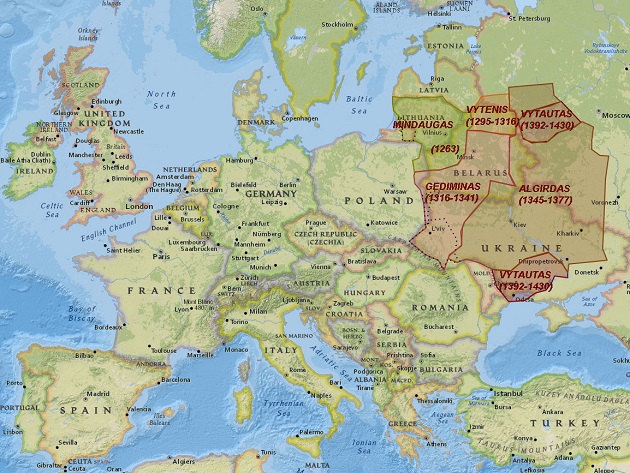

Establishment and expansion of the Grand Duchy of Lithuania, superimposed on modern European state boundaries. The areas enclosed by black dotted lines indicates regions both acquired and lost before 1430. ©Augustinas Žemaitis.
See also:
Top 10 Medieval sites in Lithuania
Grand Duchy of Lithuania ethnic relations (1253-1569)
Polish-Lithuanian Commonwealth (1569-1795)
The Union of Lublin (1569) transformed the Lithuanian-Polish relations from those of two sovereign states sometimes sharing a single monarch to a single confederation of Poland-Lithuania. Lithuanians needed this union to secure their eastern boundaries from the strengthening Russians whereas a small, but more modern Polish kingdom sought new lands (Lithuania agreed to transfer entire Ukraine to Poland).


The Union of Lublin as it was envisioned by 19th-century romantic Polish painter Jan Matejko.
The Union bought time for both countries. Immediately after the unification Poles and Lithuanians conquered Livonia (areas in what is now Latvia and Estonia). German-ruled duchies of Courland and Prussia (a newly protestant state in place of the former Teutonic Order) became Polish-Lithuanian fiefs.
However, the pressure from other Eastern and Northern powers mounted and the turning point was the Deluge when Poland-Lithuania was invaded and partitioned by Russians and Swedes (1655 – 1660). Vilnius was desecrated and burned down by Russian Cossacks and a campaign of murders and rapes followed. This was the first sack of Vilnius since the Teutonic incursions.
Poland-Lithuania managed to liberate itself but after this blow never did it become a great power again. It continued to get weaker and weaker internally. After the extinction of the Jagiellonian dynasty (1572), the monarchy became elective and every new monarch ceded more and more rights to the nobility. This way Poland-Lithuania acquired a unique political system of “Noble democracy” where most of the rights rested in approximately 10% of males known as the nobility (who participated in various parliaments or Seimas) with the rest of the population having little or no power. Even the king had to follow the wishes of his noble “subjects”.
By the late 17th century the nobility enjoyed the right of “liberum veto” where any noble could stop any political decision he doesn’t agree with. The country became effectively paralyzed because consensus could never be reached with so many people enjoying the liberum veto right.
The state was further weakened by internal conflicts between different noble families, such as Radvila and Sapiega ones. These conflicts sometimes grew into civil wars for the delight of neighboring powers (e.g. in the year 1700).
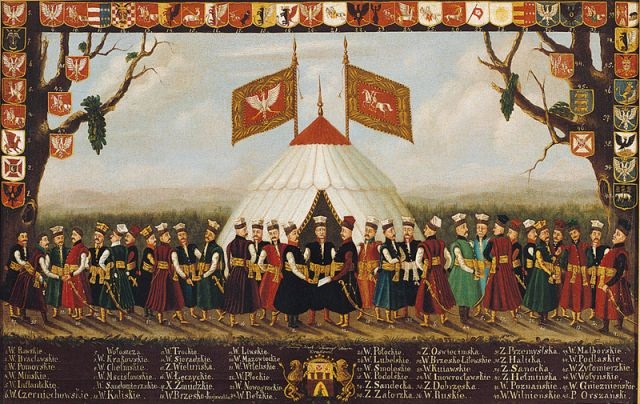

The representatives of the nobility from every voivodship of Poland-Lithuania with their local clothes and emblems. Polish (left) and Lithuanian (right) flags crown the central tent. Anonymous painting of 18th century.
Culturally Lithuania survived the reformation as a Catholic country (but minorities were respected). 46% of Grand Duchy's people were ethnic Lithuanians and 40% Belarusians but the nobility grew increasingly Polonized, adopting the Polish language which they regarded to be noble (whereas Lithuanian and Eastern Slavic languages were thought to be sufficient for peasants alone). The situation was remarkably different in Samogitia alone, where many nobles never ceased speaking Lithuanian natively.
With most Lithuanian speakers of Polish-Lithuanian Commonwealth illiterate, the center of ethnic Lithuanian culture moved to Lithuania Minor region in Prussia (east of Koenigsberg), where Lithuanians formed the majority of the population. In that area Reformation was successful and the Lutheran faith became dominant. Lutherans promoted the printing of religious books in local languages, including Lithuanian. Therefore the first Lithuanian books (e.g. “Katekizmas” by Martynas Mažvydas) were printed in Koenigsberg rather than Vilnius.
In the meantime, the Polish-Lithuanian Commonwealth became weaker and weaker both internally and externally. In 1772 the three nearby great powers (Austria-Hungary, Prussia, and Russia) conspired to partition the country. Final attempts to change the situation, such as the adoption of a new Constitution (second in the world after the US one) abolishing the liberum veto, or the uprising by Tadeusz Kosciuszko, were too little and too late. After three partitions the Polish-Lithuanian Commonwealth was eradicated from the map. The ethnic Lithuanian lands were captured by Russia and Prussia in the third partition of 1795.
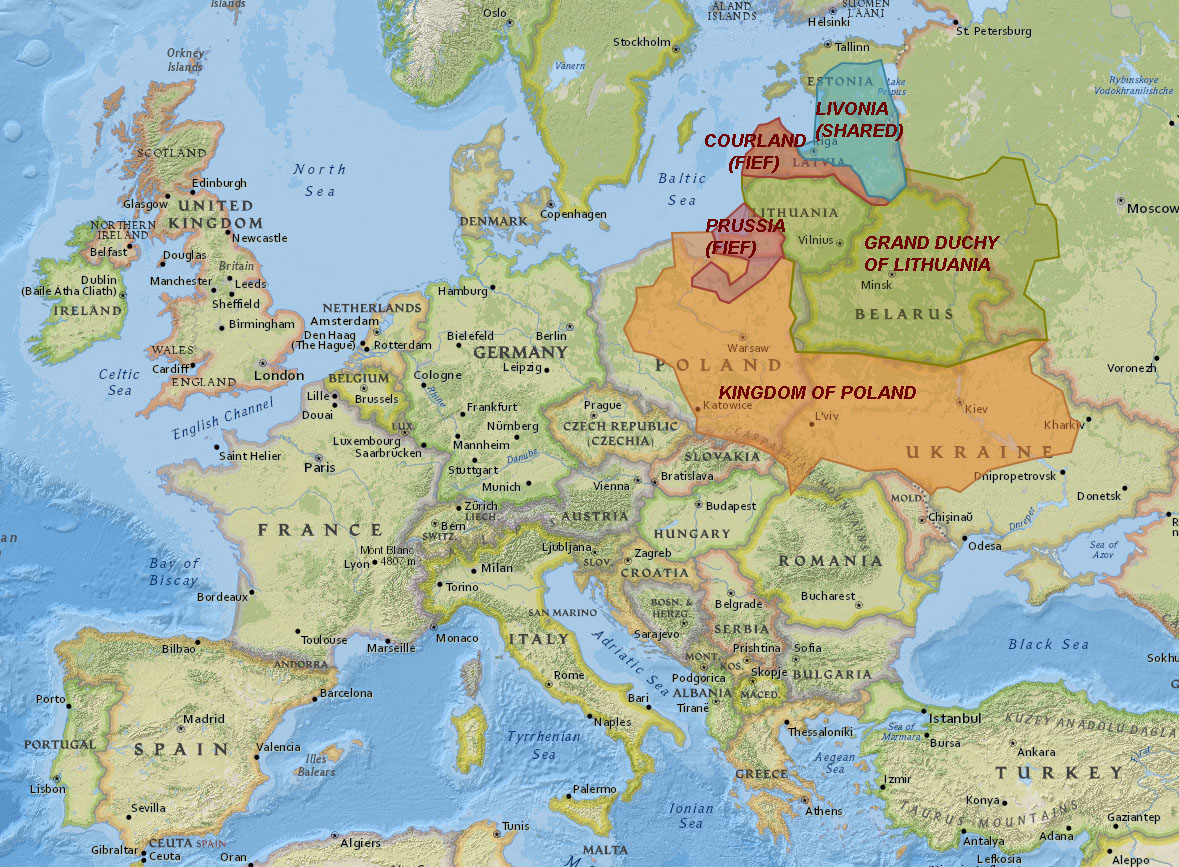

Polish-Lithuanian Commonwealth at its highest territorial extent (1616-1657) superimposed on modern European state boundaries. ©Augustinas Žemaitis.
See also:
Top 10 Polish-Lithuanian Commonwealth era sites in Lithuania
Ethnic relations in Lithuania during the union with Poland (1569-1795)
The Rule of Russian Empire in Lithuania (1795-1918)
What initially started as a mere change of the ruler from a Polish-Lithuanian king to a Russian czar eventually led to a major russification drive.
Administratively Lithuania was divided into the area directly acquired by Russia in 1795 and the area acquired from Prussia after the Napoleonic wars (in 1815). The latter was part of the nominally autonomous Kingdom of Poland and lived under the Napoleonic Code whereas the earlier was directly ruled by the Russian Empire.
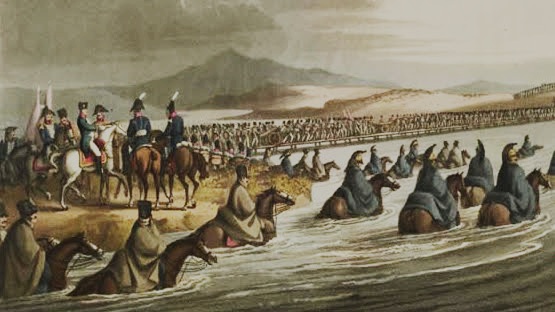

Napoleon's Grande Armee crosses Nemunas to start the doomed invasion of Russia (Kaunas, 1812). The 500000-strong army both advanced and retreated through Lithuania, leaving 80000 dead troops and hopes for Grand Duchy restoration unfulfilled.
In 1831 and 1863 the local nobility led revolts against the Russian rule attempting to restore the Polish-Lithuanian Commonwealth. Both were crushed despite some initial successes and their leaders were dispossessed. Some of the Lithuanian countryside and cities were then settled by Russians.
In the year 1832, the Vilnius University was closed. By the year 1865, printed Lithuanian language was banned. A policy of “Restoration of the Russian beginnings” was initiated as the Russian propaganda claimed that before Polonization the Lithuanian lands were, in fact, Russian.
The Roman Catholic Church was persecuted, with some church buildings torn down and some others handed over to the Russian Orthodox church. New Russian Orthodox churches sprung in the New Towns of the largest cities. The Uniates, regarded as schismatic Orthodoxes, were disbanded altogether. Mikhail Muravyov, nicknamed “The hangman”, was made the governor-general of ethnically Lithuanian governorates.


Russification era construction and destruction in Vilnius. Left image: Baroque St. Joseph church undergoing demolition (1877). Right image: a pompous unveiling of M. Muravyov statue in 1898.
The persecutions failed to defeat Lithuanians. Knygnešiai (literally “bookcarriers”) smuggled the banned Lithuanian books from the Lithuania Minor (a historical fact declared to be completely unique by UNESCO). Illegal Lithuanian-language schools were set up in villages. Catholic priest Motiejus Valančius led the Abstinence Movement aimed at resisting the Russian policy of weakening the masses through making them addicted to alcohol.
It was during the late 19th century when the popular idea of liberation among ethnic Lithuanians switched from restoration of the Grand Duchy of Lithuania to an establishment of a smaller independent state on the Lithuanian ethnic lands, leaving the rest of the former Grand Duchy to the Belarusian, Ukrainian, and Polish ethnic states. These events (altogether known as the Lithuanian National Revival) tamed the long-term assimilation-induced decline of the Lithuanian-inhabited area and their share therein.
Economically Russia was backward compared to the Western Europe and while there was some infrastructure development, such as the Saint Petersburg-Warsaw railroad of 1861 that went through Vilnius, this was far from the Western standards. Moreover, the official class division of the society was rigorously supported by the state and only in the year 1861 the farmers ceased to be regarded as a property of the local nobles.
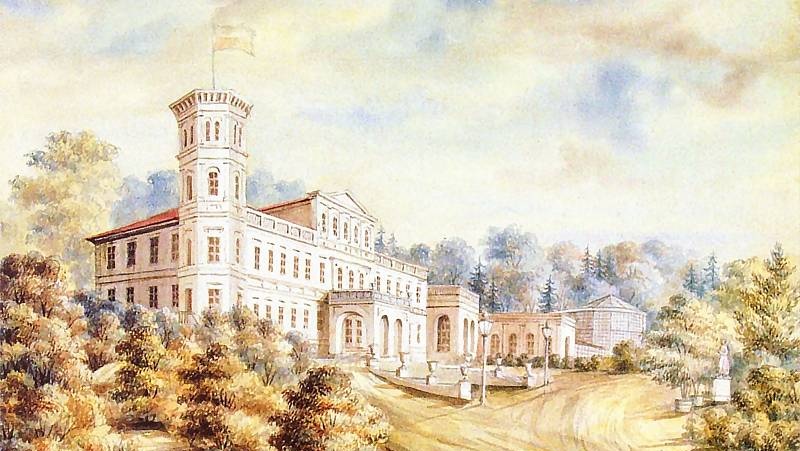

Rietavas Palace of Oginskiai family, built in mid-19th century. Lithuania's first telephone line (1882) and power station (1892) were established in this Samogitian manor. Those were the final decades before cultural/technological hubs moved from manors to the cities. Painting by Napoleon Orda.
Unlike Latvia (where Riga was among the 5 largest cities of the Russian Empire) Lithuania was expected by the Russians to remain an agricultural hinterland. The industrialization and urbanization that defined 19th century elsewhere in Europe, therefore, remained limited but the towns and cities were still growing much faster than ever before.
Lithuanians seeking industrial jobs migrated elsewhere: some to the major cities of the Russian Empire such as Riga or Saint Petersburg, others to the USA. In 1900 there were more Lithuanian speakers in Riga and Chicago than in any city in Lithuania (where the few cities that existed were dominated by Polish speakers and Jews).
In Lithuania Minor, the cities were largely German while some Lithuanian towns and villages gradually Germanized over the century. In spite of this Lithuania Minor, technologically advanced and devoid of discriminatory Russian policies, remained a fortress of Lithuanian National Revival.


'Nauja Lietuviška Ceitunga' and 'Nauja Aušra' Lithuanian newspapers, both published in 1890s Tilžė, Lithuania Minor. 'Nauja Aušra' was to be illegally distributed inside Russian-occupied Lithuania by knygnešiai (so it used Polonized orthography) while 'Nauja Lietuviška Ceitunga' was aimed at Lithuania Minor market (therefore it preferred fraktur typeset and more German loanwords).
The Russian Empire started to crumble in 1904 when it lost the war to Japan and had to give in to some demands of its minorities. Lithuanian language was permitted once again and the Lithuanian countryside sprung up with new Roman Catholic church spires.
In 1915 the Germans captured Lithuania-proper during the First World War. In 1917 Russia surrendered to Germany (after the war hardships led to a revolution in Russia) and renounced any claims to the eastern coast of the Baltic Sea, while the subsequent German losses in the Western Front led to a possibility to declare the independence of Lithuania on February 16th, 1918.


Simplified map of the ethnic-linguistic situation of Lithuania ~1900. It could not depict the mixed areas, numerous ethnolinguistic enclaves, diglossia and dual identities that prevailed alongside ethnolinguistic boundaries. ©Augustinas Žemaitis.
See also:
Top 10 Russian Imperial era sites in Lithuania
Ethnic relations in Lithuania during Russian Empire (1795-1918)
First Independent Republic of Lithuania (1918-1940)
The newly independent country faced as many as three major foreign enemies in the years between 1918 and 1921: the Bolsheviks, the pro-czar Bermontian army of former World War 1 POWs led by Pavel Bermont-Avalov and the Republic of Poland, also born at the final stages of the World War 1.
Lithuania withstood the foreign interventions, but the Polish attack in breach of the Suvalkai Treaty led to the annexation of eastern Lithuania (including the capital city Vilnius) to Poland. This was never recognized and Lithuania remained at a state of war with Poland, with the new government city Kaunas officially designated the “Temporary capital”. “We won’t calm down without Vilnius” became a popular slogan and organizations like the “Union for the Liberation of Vilnius” sprung up with the Lithuanian-Polish territorial dispute becoming one of the keystones of interwar Lithuania’s policy.


Interwar Lithuania strived to let the world know of its existence. Left is the art deco Ressurection church, built to be the largest church in the Baltics and an important landmark of rapidly expanding Kaunas. Right are Steponas Darius and Stasys Girėnas, the first Lithuanian pilots to cross the Atlantic (1933). They subsequently died in an air disaster, becoming instant martyrs.
The main western powers recognized Lithuania only in 1922 as they preferred a stronger Poland to counter the German and Soviet threats. But by 1922 it was already clear that the Polish-Lithuanian Commonwealth will not be reborn as the Poles ceded many eastern lands to the Soviets in the Treaty of Riga.
Unlike the part of Lithuania that was in the Russian Empire, Lithuania Minor remained under German rule except for its northernmost part, the Klaipėda Region (German: Memelland), which was detached from Germany due to its Lithuanian majority. As the Lithuanian Republic was still unrecognized, Klaipėda Region remained under League of Nations rule. In 1923 Lithuania supported a revolt in Klaipėda Region and the new directory (government) of Erdmonas Simonaitis joined Lithuania (as a bilingual autonomous area) thereby giving the young country its only seaport. Together with it came a sizeable German minority which caused trouble in the 1930s when the Nazi ideas caught on among the Germans of Klaipėda Region.
1926 saw a military coup and the new president Antanas Smetona ruled until the end of independent Lithuania, with the period thus frequently known as the “Smetonic era”. Lithuania became one of the first authoritarian countries in Eastern Europe, but by the year 1936 only a few, such as Czechoslovakia, would still remain democratic.


President Antanas Smetona takes oath before a Catholic bishop.
Interwar Lithuania continued to be an agricultural society with only 20% of people living in cities, therefore it was less heavily hit by the Global Depression, remained a devout Catholic land with the church not disestablished and birth rates soaring (the population increased by 22% to over 3 million in years 1923-1939 despite a sizeable emigration primarily to the South America).
The foreign policy of Lithuania was friendly to the Germans and Soviets because of many other countries, like France or Estonia, supporting Poland in the conflict over Vilnius. However, the increasing imperialism of both Germany and the Soviet Union eroded their need for independent Lithuania. In 1939 German ultimatum led to the loss of the Klaipėda Region. A secret Molotov-Ribentropp pact protocol included Lithuania in the German zone of influence, but the Smetona’s refusal to invade Poland together with Germany led to the change in the protocol with Lithuania being “ceded” to the Soviet Union. In 1939 Soviet Union established army bases in Lithuania after an ultimatum (this ultimatum also returned 1/5th of the Vilnius region, recently occupied by the Soviets during their invasion of Poland), and another ultimatum in 1940 led to a full-scale occupation and annexation.


A moment of Lithuania-Hungary game during the 1939 European Basketball championship in Kaunas. Lithuanian team became European champions in 1937, catapulting basketball to the level of national sport and winning the right to host the 1939 event, where they successfully defended the title.
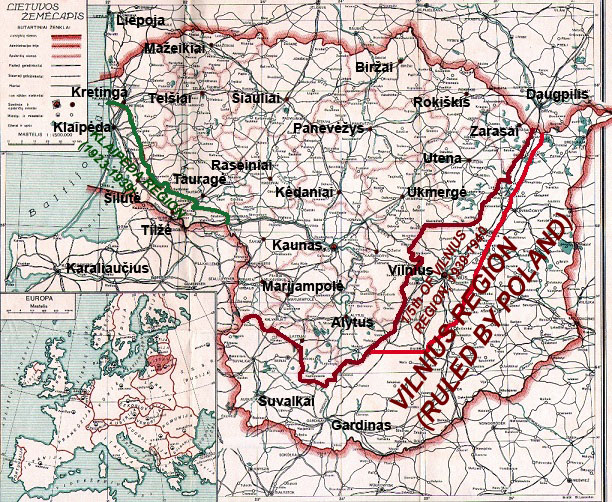

A map of interwar Lithuania with some new information for clarity. Klaipėda region and Vilnius region are marked.
See also:
Top 10 interwar sites in Lithuania
Ethnic relations in interwar Lithuania (1918-1939)
World War 2 in Lithuania (1940-1944)
The cruelties of first Soviet occupation, of a scale not seen in Lithuania since the Russian Empire rule, led to a widespread despise of the regime in less than a year. For example in four days between June 14 and June 18 of 1941 alone some 40 000 people from educated families were exiled to Siberia and Soviet labor camps (almost half of them 16-year-old or younger, 556 infants under 1 year, families typically separated), most never to return alive. Others were arrested with many later tortured and massacred in places like Rainiai and Cherven.


Lithuanians murdered by the Soviets in Rainiai massacre, one of the brutal mass murders in World War 2 Lithuania. Out of the at least 73 bodies, only 27 could be identified due to mutilations. Prior to death, the victims were tortured: their genitals severed and put into their mouths, eyes picked out, bones crushed, skin burned by hot water and acid, they suffered electrocution. The victims were recently arrested by the Soviets for such 'crimes' as participating in the Boy Scout movement or owning a Lithuanian flag.
When the German Reich declared war on the Soviet Union the Lithuanians staged a June Revolt and managed to liberate most of the country. However, the German armies came in and while Germany did not immediately abolish the provisional government (possibly hoping for similar anti-Soviet revolts elsewhere) they rendered it powerless. By August all forms of self-rule were extinguished; by November all Lithuanian political parties banned.
The new Nazi German occupation brought a relief from the Soviet persecutions but it had its own target: the Jews. Some of them have fled Europe (never to return), most of the rest were killed (often after a brief life in forced ghetto or a deportation to a concentration camp in German-ruled lands elsewhere). The number of Jews living in Lithuania declined by ~88% by the time of 1959 census.
By 1944 the Germans were losing the war and the Soviets occupied Lithuania yet again. Knowing what to expect some 100 000 Lithuanians fled Lithuania beforehand. Two Soviet occupations led to a far greater loss of life than the Nazi German occupation, leading to a popular opinion that World War 2 ended for Lithuania only in 1990. Lithuania lost ~8% of its pre-WW2 inhabitants due to Nazi actions and ~32% due to Soviet actions (until the year 1953), some 40% in total (1,15 million out of 3 million). 1/3 to 1/2 of this number were killed. Well over 90% of the victims were civilians.


Statistics of people lost to Lithuania 1940-1959, both per event and per perpetrator. The tables are compiled consulting multiple sources (turmoil and subsequent propaganda made the exact figures impossible to find out, so approximations vary somewhat per source. Moreover the boundaries of Lithuania switched multiple times in the era). The per-event table lists the murdered and the refugees/deportees in separate rows where possible; where impossible they are put together and the approximate share of those killed is provided instead (most/many/some).
See also: Ethnic relations in World War 2 Lithuania (1939-1945)
Soviet Occupation of Lithuania (1944-1990)
From the Soviet occupation in 1944 to the death of Stalin in 1953 Eastern Europe was a Stalin’s playfield with human rights practically non-existent. The Lithuanian nation was not expelled in its entirety, unlike Chechens or Crimean Tatars for example, but as many as half a million Lithuanians were, either dying or losing health in the cold GULAGs of Siberia. Others were executed or died in prisons. Additionally, many of Lithuania’s Poles (200 000) were expelled to Poland by Stalin (in trains marked with slogans “We are returning home” despite the fact that the Polish-speaking minority existed in Lithuania for centuries). Lithuanians of Klaipėda region were expelled to Germany together with the Germans of Lithuania (170 000 people). At the same time, Lithuanian cities like Vilnius and Klaipėda were heavily settled by ethnic Russians with Lithuania’s Russian population share increasing more than threefold in a decade (from 2,5% to 8,5%). All these persecutions triggered the longest major guerilla war in modern Europe. This Lithuanian armed resistance was crushed by large Soviet forces by mid-1950s with some 30 000 partisans killed. Under Stalin, Lithuania lost 32% of its pre-WW2 population. More precise numbers of victims are in the article on World War 2.
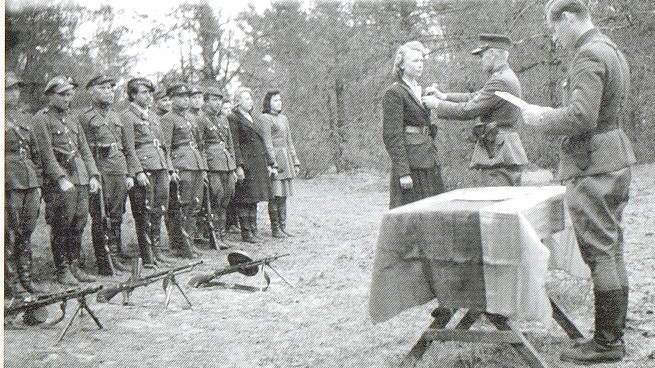

Lithuanian freedom fighter officer awards a female citizen. In 1944-1953 Lithuanian forests sheltered an entire guerilla state with its own government, army, and courts of law. Some vainly hoped for Western help, for the others tough life in forest helped avoid an even quicker death in Soviet genocide. In order to intimidate the remaining population Soviets used to publically display guerilla corpses in town squares.
Furthermore, most of Lithuania Minor was annexed to Russia as Kaliningrad Oblast. After a brutal genocide (300 000 locals murdered, among them 130 000 Lithuanians) the region's population was replaced by Soviet settlers and new Russian placenames were coined for its towns and features. This effectively ended the history of Lithuania Minor.
Nikita Khrushchev’s destalinization (1953-1964) changed some policies (those people exiled to Siberia who were not yet dead gained limited freedom and the settling of Lithuania by ethnic Russians slowed down) but most things left unchanged. The agriculture remained collectivized and its outputs greatly diminished (especially when taking into regard the improved technologies), the property remained nationalized, the ownership of Lithuanian symbols and any criticism of communism or the Soviet occupation were still punished by long terms of imprisonment (in jails or insane asylums) and the Lithuanians living in other parts of Soviet Union as well as those living in the multi-ethnic Vilnius region were Russified.


An example of all-encroaching Soviet propaganda, this is an early Soviet era postcard of Vilnius Gedimino Avenue. The number of cars is artificially increased to make the Union look more affluent (in reality car remained a luxury until the USSR dissolution in 1990). All photographers had to follow guidelines (for instance, not to take pictures of wooden homes) and no foreigner was meant to see the real life of the Soviet citizens.
Soviet Lithuania was isolated from the non-Soviet world with travel restrictions both for foreigners to enter anywhere except for several designated tourist places, and for the locals to travel abroad. Religion and the religious were persecuted and many Roman Catholic churches, as well as all the monasteries, were closed down with the number of open Catholic churches in Vilnius becoming the same as that of Russian Orthodox churches despite there being ten Catholics for every single Orthodox.
The Soviet economy was plagued by the popular belief that “Everything belongs to everybody, and therefore everything belongs to nobody” and stumbled well behind the Western European one. People were widely stealing from their workplaces and this was regarded as a normal practice by the society, therefore condoned by the peers and even many CEOs. Few people (if any) were rich in terms of money but the community was far from egalitarian because it was who you knew that mattered the most: the people who had important friends also had access to many things that were inaccessible to most others, e.g. better cars, larger apartments, modern TV sets or warm-climate fruits (these things were inaccessible to many partly because they used to be taken by those who had important “relationships”).


A new concrete slab borough under construction in Vilnius in 1980. Such buildings provided a home for former peasants, settlers from Russia and those evicted from old houses alike. Urbanization level increased from 30% to 70% in 1939-1989. In 1989 some 60% of the city dwellers lived in these 1960s-1980s boroughs.
Still, however, the Lithuanian economy remained one of the most robust ones inside the Soviet Union – in Central Asia, Siberia or the Caucasus the situation was even worse. The economic hardships, as well as the inability to maintain a large army and secret service network (that was necessary to subdue any resistance in the Soviet Union and elsewhere in the Eastern Europe), led to Mikhail Gorbachev’s policies of Perestroika and Glastnost (1985), or the move towards capitalism and democracy.
In Lithuania, this led to the establishment of Sąjūdis (The Movement) led by musician Vytautas Landsbergis. It took an increasingly pro-independence stance and its protests were attended by hundreds of thousands. The pro-independence underground always existed in Lithuania in the form of Lithuanian Freedom League or the Roman Catholic secret newspaper describing the brutality of the Soviet regime. But only by the year 1988, the majority of Lithuanians dared to tell their thoughts publically.


Baltic way - the 600 km long human chain of some 2 million people that connected Vilnius, Riga, and Tallinn (total population of the Baltic States was 7,5 million). It demonstrated the unity of the Baltic States and the determination to achieve freedom. The idea of this protest form was later copied by political movements as far away as in Israel and Taiwan, but neither the size nor the length of the human chain was ever surpassed.
See also:
Top 10 Soviet occupation era sites in Lithuania
Ethnic relations in Soviet-occupied Lithuania (1945-1990)
Restored Independent Lithuania (1990 And Beyond)
In 1990 Sąjūdis won the first free elections in Lithuania and the independence was restored on March 11th, 1990. The Soviets subsequently attempted to reimpose their control by force and the attack of January 13th, 1991 led to the deaths of 14 unarmed civilians (together with tens of thousands of others, they protected key buildings such as the Vilnius TV tower and the Supreme Council from the Russians). On July 31 of 1991, seven customs officers were killed by Russian forces on the newly established Lithuanian-Belarusian border. These attempts consolidated the Western support for the Lithuanian independence and de jure recognitions started to pour in by early 1991 (many countries, like the USA, never recognized the occupation of Lithuania and thus did not have to recognize independence). By the end of 1991, the Soviet Union completely collapsed and turned into 15 independent countries. Russians withdrew their final soldiers from Lithuania by 1993 (the first completed withdrawal in entire Eastern Europe).
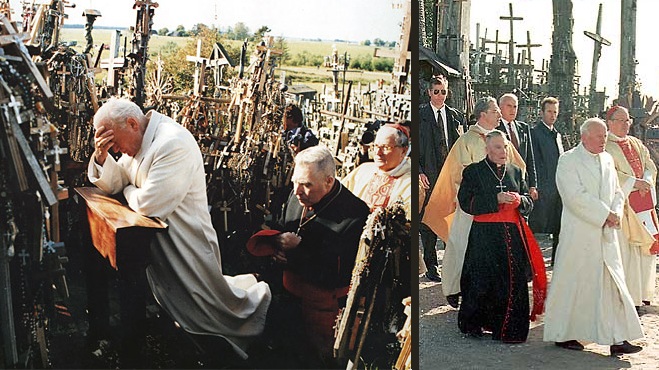

Pope John Paul II in the Hill of Crosses during his 1993 visit of Lithuania. Unimaginable under the Soviet anti-religious regime merely 5 years ago this event boosted Lithuanian morale and signified regained freedom. John Paul II and the Vatican were always sympathetic to Lithuania.
Long-awaited independence brought many personal freedoms which the people had eagerly sought. This was an era of massive new churches, telenovelas and anime on prime-time TV, hip-hop, mass import of used non-Soviet cars, and the first travels to the West. Criminal news (hidden from the public in the Soviet Union) were now the first pages of a newspaper a regular reader would skim. It was easier for new ideas to gain acceptance than ever before or since.
Private property was again the norm and nationalized land was returned to former (pre-1940) owners where possible. Everybody who lived in Lithuania by the time it restored independence (1990) was allowed to get the Lithuanian citizenship (regardless of his/her ethnicity or language skills), therefore Lithuania avoided the problem of stateless people that plagued Latvia and Estonia.
Freedom euphoria was, however, joined by a hardship of economic transition. Factories that had been built for the Soviets were horribly outdated and unable to compete in the free market both due to low technology and their management not understanding things such as marketing. The inefficient system of collective agriculture has been swiftly disbanded. Only a small part of these Soviet-established businesses survived.
In the meantime, Lithuanians started new businesses in places like Gariūnai marketplace with some of these early traders now being millionaires or billionaires, like Nerijus Numavičius of VP Grupė whose Maxima supermarket chain later catapulted him into the Forbes billionaire list.


'Metal garage districts' were one of the 1990s peculiarities. Car ownership rates soared but few would drive every day or keep cars near home, having opted for such far-away garages instead. This Bing Bird's eye image taken in 2009 shows a largely abandoned 'garage city' in Vilnius which has subsequently been cleared for IKEA mall.
The early years of Lithuanian economy (1990 – 1995) had a frontier feeling with organized crime (especially extortion) burgeoning. Some people that stood in the "mafia's" way (businessmen, a journalist, prosecutors) were murdered. Only by 1995, the police was strong enough to defeat the villains; the Vilnius crime boss Boris Dekanidze was sentenced to death while the Kaunas “Godfather” Henrikas Daktaras served a term in prison.
By 1997 the lawless businesses gave way to modern developments, while certain key state institutions (telecommunications, passenger sea lines, oil refinement) were privatized by foreign consortiums. What started with the first skyscrapers of Vilnius in 2000 quickly expanded to other main cities. By the year 2003, Lithuania was effectively a modern society.


Outdated Šiaulių oda Soviet factory, once abandoned (left), has been transformed into modern shopping mall Bruklinas in 2007 (right). Lithuanian entrepreneurs pioneered massive shopping mall development in Eastern Europe in the 2000s. Right image ©Augustinas Žemaitis.
In the year 2004, Lithuania joined the European Union and NATO, both memberships having been a major foreign policy goal since independence. European Union membership required an adaptation of Lithuanian laws, ushering the end of 1990-2004 libertarian Lithuania. Entrepreneurship decreased, bureaucracy replaced idealism while political correctness engulfed the freedom of speech.
Foreign policy goals in the East were less successful with Russia (also Israel and Belarus) refusing to try the Soviet war criminals now residing in these countries. After the rise of Vladimir Putin, Russia refused to recognize the Soviet occupation of Lithuania altogether claiming that the Soviet Union had “liberated Lithuania”.
Despite independence, Lithuania at first remained completely dependent on the Russian gas and oil imports, as there were no infrastructure connections to the West. Building alternative means to ensure commodity supply was among the first major goals of Lithuania, achieved with Būtingė Oil Terminal (1998), Klaipėda Liquid Gas Terminal (2014) and electricity connections to the West. While going for "energetic independence", Lithuania of 1990s and 2000s still often tried to pursue so-called "pragmatic policy" vis-a-vis Russia ("forgetting the past to have more opportunities today"), hoping its companies would be able to export the know-how to the Russian market. Russian films, music, and TV were still quite popular in Lithuania at the time. However, with the rise of the Russian imperialism in 2008 (Georgia war) and especially 2014 and 2022 (Ukraine war), Lithuanian last remaining economic and cultural ties with Russia disintegrated.
The post-independence economic growth has been sweeping but the Soviet occupation left Lithuania decades behind the West (leading to lower salaries). Some Lithuanians refused to wait and opted to leave their homeland instead (primarily to the United Kingdom and Ireland). This emigration gained epic proportions after Lithuania’s admission into the European Union made it legal to settle anywhere in Western Europe. The population of Lithuania went down from 3,5 million to 3 million people in a decade between censae of years 2001 and 2011. Currently, the population of Lithuania is even smaller than that before the World War 2. Such emigration levels are unheard of anywhere outside of the countries struck by wars and disasters.


Comparison of economies (left) and populations (right) in Lithuania and Finland. Prior to 1940 Lithuania and Finland had similar histories and economies. After Soviet occupation however the Lithuanian GDP per capita amounted to merely 21% of the Finnish one but it has been steadily growing since (55% by 2013). However, the relative decline of Lithuanian population continues. Lithuanian population amounted to 83% of Finnish population in 1940, 74% in 1990 (300 000 Soviet settlers failed to compensate for the 1940-1953 genocides) and merely 57% today. ©Augustinas Žemaitis.
See also:
Top 10 post-independence sights in Lithuania
Ethnic relations in modern Lithuania (1990-)


